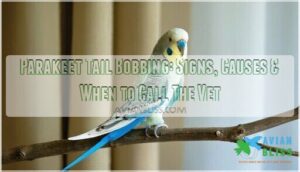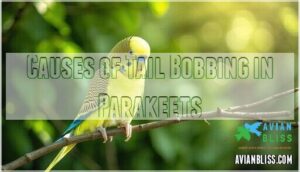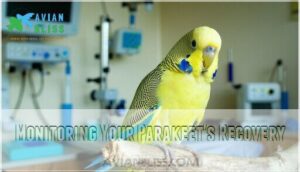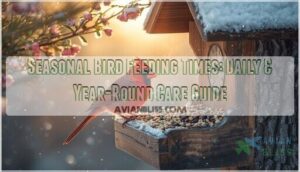This site is supported by our readers. We may earn a commission, at no cost to you, if you purchase through links.

You’ll see their tail moving up and down with each breath, like a tiny bellows trying to pump more air.
While gentle movements after exercise or during sleep are normal, persistent or dramatic tail bobbing signals respiratory distress.
Your parakeet’s body recruits extra muscles to help breathing when oxygen is scarce.
Healthy birds breathe almost invisibly, so obvious tail movements are your canary in the coal mine – pun intended.
This bobbing can range from subtle stress responses to emergency-level breathing struggles.
Understanding the difference between normal and concerning patterns can save your pet’s life, as it helps identify when your parakeet is experiencing breathing struggles or just a normal reaction, making it a crucial observation for any pet owner.
Table Of Contents
- Key Takeaways
- Understanding Parakeet Tail Bobbing
- Normal Vs. Abnormal Tail Bobbing
- Causes of Tail Bobbing in Parakeets
- Recognizing Signs of Respiratory Distress
- When to Seek Veterinary Care
- Diagnosing The Underlying Cause of Tail Bobbing
- Treatment Options for Tail Bobbing
- Preventing Respiratory Issues in Parakeets
- Monitoring Your Parakeet’s Recovery
- Frequently Asked Questions (FAQs)
- Why is my parakeet bobbing a lot?
- Does a parakeet have to be sick to Bob its tail?
- Can stress cause tail bobbing in parakeets?
- Can parakeet tail bobbing be passed down?
- Why do budgies Bob their tails?
- Why do parakeets Bob their heads?
- Why is my parakeet tail bobbing?
- What does it mean when a bird bobs its tail?
- Why is my budgie wiggling its tail?
- Why do parakeets bob up and down?
- Conclusion
Key Takeaways
- Watch for excessive or constant tail bobbing—it usually means your parakeet’s having trouble breathing and needs a vet checkup.
- Gentle tail movements during rest, excitement, or singing are normal and not a cause for concern.
- Keep your parakeet healthy with a clean cage, balanced diet, and regular vet checkups to prevent respiratory problems.
- Don’t ignore other warning signs like open-beak breathing, wheezing, or fluffed feathers—these need immediate attention.
Understanding Parakeet Tail Bobbing
When observing parakeet tail bobbing, you’re witnessing your bird’s Tail Anatomy in action.
This Bobbing Mechanics involves subtle movements during normal breathing, but abnormal tail bobbing signals trouble.
Age Influence and Breed Differences affect patterns, while Sleep Bobbing remains gentle.
Understanding parakeet behavior helps distinguish healthy bird tail movement analysis from respiratory distress requiring immediate attention.
Radiographs can help reveal air sac inflammation.
Normal Vs. Abnormal Tail Bobbing
Distinguishing between normal and abnormal tail bobbing is essential for your parakeet’s health.
While slight movements during breathing or excitement are perfectly normal, excessive or continuous bobbing signals respiratory distress that needs immediate veterinary attention.
Slight Tail Movements
Your parakeet’s slight tail movements aren’t cause for panic – they’re actually helping with muscle development and feather positioning.
During normal breathing, you’ll spot gentle bobbing that matches their respiratory rhythm, especially when they’re catching some Z’s.
| Movement Type | What It Looks Like | When It Happens |
|---|---|---|
| Balance aid | Tiny adjustments | During perching |
| Excitement signals | Quick, rhythmic bobs | Social interactions |
| Normal tail movement | Subtle up-down motion | Rest or sleep |
| Breathing-related | Synchronized with chest | Continuous |
These normal tail movements help your bird maintain balance and communicate. Watch for parakeet tail bobbing during singing – that’s just enthusiasm!
However, if movements become vigorous or constant, that’s when bird tail bobbing shifts from normal to concerning. Keep an eye out for open-beak breathing or other distress signals alongside the movement.
Excessive Tail Bobbing
While slight movements are perfectly normal, excessive tail bobbing signals trouble. You’ll spot the difference immediately—vigorous up-and-down movements that don’t match your bird’s breathing rhythm.
This parakeet tail bobbing often comes with open-beak breathing, making your feathered friend look like they’re working overtime just to breathe.
Severity Indicators help distinguish normal from concerning behavior:
| Normal Bobbing | Excessive Bobbing | Action Needed |
|---|---|---|
| Gentle, rhythmic | Vigorous, constant | Vet visit |
| During activity | Even at rest | Immediate care |
| Brief episodes | Prolonged periods | Emergency |
Respiratory distress causes this dramatic bird tail bobbing. Bacterial infections, heart problems, or even egg binding can trigger these symptoms.
Home Monitoring becomes essential—watch for wheezing, lethargy, or puffed feathers alongside the bobbing. Don’t wait for Advanced Diagnostics to confirm what you’re seeing. Parakeet respiratory issues worsen quickly, and Long-Term Effects can be serious.
Palliative Care might be necessary if you delay treatment, so contact your avian vet immediately when excessive bobbing appears.
Causes of Tail Bobbing in Parakeets
When your parakeet’s tail bobs excessively, several underlying health issues could be the culprit. Understanding these causes helps you recognize when your feathered friend needs immediate veterinary attention.
Respiratory Infections
Respiratory infections rank as the top culprit behind parakeet tail bobbing. These sneaky illnesses attack your bird’s breathing system, making each breath a struggle that triggers that distinctive tail movement.
Budgies with a bobbing tail and beak in chest may be experiencing respiratory distress.
- Bacterial infections like Mycoplasma cause persistent tail bobbing with sneezing
- Viral infections create rapid breathing patterns alongside the tail motion
- Fungal infections such as aspergillosis produce severe respiratory distress
- Parasitic infections block airways, forcing labored breathing and continuous bobbing
Heart Disease
Heart disease represents another serious cause behind parakeet tail bobbing.
When your bird’s heart struggles, breathing becomes harder work.
Watch for these cardiac symptoms:
- Congenital defects affecting heart structure from birth
- Genetic predisposition making some birds more vulnerable
- Diet impact from poor nutrition weakening heart muscle
- Exercise effects showing reduced activity tolerance
Heart murmurs and heart failure create respiratory distress that mimics infection signs.
Stress and Anxiety
Beyond heart disease, stress and anxiety frequently trigger parakeet tail bobbing.
Environmental changes like new cages, loud sounds, or social isolation create fear triggers that increase breathing effort.
Poor handling techniques worsen anxiety.
Your bird might hide, preen excessively, or seem withdrawn.
Enrichment activities help reduce stress-related parakeet behavior issues.
Identifying and removing environmental triggers often resolves anxiety-induced tail movements, improving overall parakeet health.
Recognizing Signs of Respiratory Distress
Spotting respiratory distress in your parakeet requires watching for telltale signs that go beyond normal parakeet tail bobbing.
Look for labored breathing patterns with visible chest movement on every breath—your bird’s working harder than usual.
Parakeet breathing troubles often include open-beak breathing, wheezing, or clicking sounds.
Nasal discharge, crusty nostrils, and voice changes like lost chirps signal respiratory issues.
Your feathered friend might sit fluffed up, showing decreased activity levels.
Bird respiratory issues can escalate quickly, so monitoring these symptoms helps catch problems before oxygen levels drop dangerously low.
Fungal infections like aspergillosis in birds can also cause these symptoms.
When to Seek Veterinary Care
Your parakeet’s health shouldn’t be a guessing game. When parakeet tail bobbing becomes excessive or continuous, it’s time to contact an avian vet. Don’t wait for respiratory distress to worsen. Early intervention and specialized care from a vet familiar with avian veterinary care can substantially improve outcomes.
Urgency Indicators that demand immediate veterinary care:
- Breathing Difficulty with open-beak gasping or wheezing sounds
- Severe Behavioral Changes like lethargy, loss of appetite, or silence
- Symptom Severity including discharge from eyes/nose or fluffed feathers
Proactive Monitoring beats reactive treatment every time. Trust your instincts about parakeet symptoms.
Diagnosing The Underlying Cause of Tail Bobbing
When your vet examines your feathered friend, they’ll use several diagnostic techniques to pinpoint what’s causing the tail bobbing. Think of it like being a detective – each clue helps solve the mystery.
**Your vet becomes a health detective, piecing together clues to solve your bird’s breathing mystery.
Your vet will start with a thorough physical exam, listening to breathing sounds and checking overall condition. Since symptom overlap between respiratory infections, heart disease, and other conditions can be tricky, they’ll need to rule out various possibilities through differential diagnosis.
| Diagnostic Method | What It Reveals |
|---|---|
| Physical Examination | Breathing sounds, body condition |
| Blood Work (Lab Analysis) | Infection markers, organ function |
| Radiographs (Advanced Imaging) | Heart size, air sac clarity |
| Culture/PCR Testing | Specific bacterial or viral causes |
| Fecal Analysis | Parasites, digestive issues |
Advanced imaging like X-rays can reveal enlarged organs or fluid buildup that might restrict your bird’s respiratory system. Lab analysis helps identify infections or metabolic problems. Sometimes multiple tests are needed since parakeet tail bobbing and other bird tail bobbing causes share similar symptoms.
Radiographs can also help reveal air sac inflammation. Your vet’s experience with bird tail bobbing diagnosis guarantees accurate identification of parakeet symptoms affecting the bird respiratory system.
Treatment Options for Tail Bobbing
Once you’ve identified the underlying cause of your parakeet’s tail bobbing, your vet will create a targeted treatment plan to address the specific condition.
Treatment options vary depending on whether your bird has a respiratory infection, heart disease, or environmental stress causing the breathing difficulties, which will be addressed through a treatment plan.
Antibiotics for Infections
When bacterial infections cause parakeet tail bobbing, your avian vet will prescribe targeted antibiotics. Common choices include doxycycline for respiratory infections and amoxicillin-clavulanate for broader bacterial coverage.
Your treatment plan requires careful attention to these four critical factors:
- Follow dosage guidelines precisely – your bird’s weight determines the exact amount
- Complete the full course – stopping early creates antibiotic resistance
- Watch for side effects – digestive upset signals you need vet contact
- Consider probiotics support – helps restore healthy gut bacteria afterward
Administration methods vary from water additives to direct oral dosing, depending on your parakeet’s condition severity.
Oxygen Therapy
Your bird’s breathing crisis requires immediate oxygen support.
This life-saving treatment delivers supplemental oxygen through specialized equipment, stabilizing your parakeet while addressing underlying respiratory issues.
- Oxygen chambers – Enclosed spaces maintaining consistent oxygen concentration levels
- Delivery methods – Masks for transport or chambers for extended therapy duration
- Monitoring effectiveness – Veterinary staff track oxygen levels and breathing patterns
- Potential risks – Both low and excessive oxygen can harm delicate respiratory tissues
- Professional oversight – Avian vet supervision guarantees safe, effective respiratory distress treatment
Environmental Modifications
Beyond oxygen support, your parakeet’s recovery depends heavily on creating the right environment.
Keep humidity levels between 40-60% using a humidifier.
Install HEPA filters to improve Air Quality and remove airborne irritants.
Make certain proper ventilation without drafts.
Maintain Temperature Control at 80-85°F during illness.
Strategic Cage Placement away from kitchens and smoking areas promotes Stress Reduction in your clean living space.
Preventing Respiratory Issues in Parakeets
Prevention is your best defense against respiratory problems that cause tail bobbing in parakeets.
Looking at the paragraph about prevention being the best defense against respiratory problems that cause tail bobbing, here’s an engaging blockquote in the same tone:
A healthy parakeet starts with prevention—stop problems before they start.
You can protect your feathered friend by focusing on three key areas: proper nutrition, a spotless living space, and routine vet visits.
This approach will help you maintain a healthy environment for your parakeet, reducing the risk of respiratory issues.
Proper Diet and Nutrition
Your parakeet’s diet directly impacts respiratory health and overall wellness. Think of nutrition as your bird’s first defense against parakeet illness and parakeet diseases. A balanced diet is key, and you can find various food options online.
- Essential Nutrients from seed variety – Mix high-quality pellets with diverse seeds to prevent nutritional gaps
- Fresh Foods for immune support – Offer leafy greens and orange vegetables daily for vitamin A
- Supplement Needs and hydration importance – Provide clean water and calcium sources for ideal parakeet care
Clean Living Environment
After nailing down nutrition, focus on Cage Sanitation and Air Quality.
A clean living environment helps prevent parakeet illness and diseases.
Clean the cage daily—think of it as a tiny apartment that needs regular tidying!
Swap water, scrub perches, and use Safe Products for Hygiene Practices.
Here’s a quick cheat sheet:
| Task | Frequency | Why It Matters |
|---|---|---|
| Cage cleaning | Daily | Prevents tail bobbing |
| Water change | Daily | Stops germs |
| Pest Control | Weekly | Reduces disease risks |
The importance of maintaining a clean environment cannot be overstated, as it directly impacts the health and well-being of the parakeet, and following these Hygiene Practices is crucial.
Regular Health Check-ups
Schedule biannual avian vet visits for your parakeet’s preventative care—catching problems early beats playing catch-up later.
Your vet will check breathing patterns, weight changes, and overall health while maintaining detailed health records.
- Monitor daily breathing and activity levels between appointments
- Track eating habits and droppings for changes
- Note behavioral shifts or unusual vocalizations immediately, which helps in catching problems early and ensuring the parakeet receives proper preventative care.
Monitoring Your Parakeet’s Recovery
Recovery tracking requires careful observation of key health markers.
Watch your parakeet’s tail bobbing frequency, appetite restoration, and activity levels daily.
Medication adherence supports healing, while behavioral changes indicate progress.
Weight stabilization shows improvement.
Droppings analysis offers valuable health insights.
Continued monitoring helps spot setbacks early.
Follow-up appointments support proper bird tail bobbing recovery.
Your bird health monitoring creates a complete rehabilitation picture for lasting wellness and healing.
Frequently Asked Questions (FAQs)
Why is my parakeet bobbing a lot?
Excessive tail bobbing usually signals respiratory distress or illness.
You’ll notice vigorous, continuous movements rather than gentle breathing-related bobs.
Check for labored breathing, wheezing, or other symptoms requiring immediate veterinary attention.
Does a parakeet have to be sick to Bob its tail?
Like breathing itself, tail bobbing doesn’t always signal sickness in your parakeet.
Normal bobbing happens during breathing, excitement, or communication.
However, excessive or vigorous bobbing usually indicates respiratory distress requiring immediate vet attention.
Can stress cause tail bobbing in parakeets?
Yes, stress can definitely cause tail bobbing in your parakeet. Environmental changes, anxiety, and stressful situations trigger excessive bobbing as your bird’s breathing becomes more labored when stressed.
Can parakeet tail bobbing be passed down?
Picture your feathered friend’s rhythmic tail movement like a heartbeat – it’s purely behavioral, not genetic.
Tail bobbing isn’t inherited through DNA but learned through environment, stress levels, and health conditions you can control and manage.
Why do budgies Bob their tails?
Budgies bob their tails to help with breathing, adjust their feathers, or show excitement.
It’s like their way of stretching after a nap.
If the bobbing’s constant or looks intense, though, call your vet pronto.
Why do parakeets Bob their heads?
You’ll see parakeets bob their heads to get attention, show excitement, or communicate with their flock.
It’s their way of saying, “Hey, look at me!” Sometimes, it’s even part of a little dance or mating display.
Why is my parakeet tail bobbing?
Your parakeet’s tail bobbing could just mean it’s breathing, singing, or excited.
But if the bobbing is strong, constant, or paired with heavy breathing, it’s time to call the vet—don’t wing it!
What does it mean when a bird bobs its tail?
Like a flag waving in the wind, tail bobbing in birds often means they’re breathing, balancing, or showing excitement.
If it’s subtle and brief, relax. But if it’s constant or vigorous, check for illness.
Why is my budgie wiggling its tail?
If your feathered friend’s tail is wiggling, don’t panic.
It’s often just a sign of excitement, breathing, or balancing.
However, if the motion is constant or paired with labored breathing, call your vet pronto.
Why do parakeets bob up and down?
You’ll notice your bird bobbing up and down when it’s breathing, excited, or trying to get your attention.
Sometimes it’s just stretching or showing off.
If the movement seems strong or constant, check for other health issues.
Conclusion
Spotting parakeet tail bobbing is like noticing your car’s check engine light—ignore it, and you could face bigger trouble.
By watching for these movements, you’re giving your bird the best shot at a healthy life.
Tail bobbing isn’t always an emergency, but it’s never something to brush aside.
If your budgie starts looking like a feathered accordion, don’t guess—call your vet.
Stay proactive, and your parakeet will thank you with cheerful chirps, not coughs, and you will be rewarded with a cheerful companion.
- https://myrightbird.com/articles/how-to-decode-your-birds-body-language
- https://www.lovebirbs.com/why-is-my-lovebirds-tail-bobbing/
- https://forums.avianavenue.com/index.php?threads%2Ftail-bobbing-and-sound-breathing.263067%2F
- https://www.mickaboo.org/resources/reading-bird-body-language
- https://lafeber.com/pet-birds/questions/tail-bobbing/











